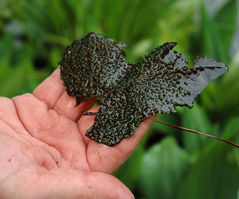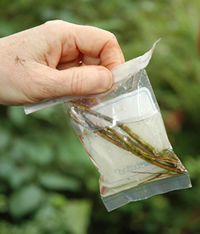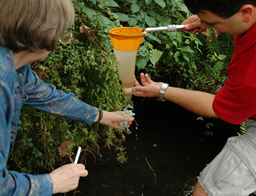UA Professor Noted Danger in Ignoring Fungus, What if the World Had Listened?
By Chris Bryant

If anyone or anything ever needed a champion to take up its cause, it was the lowly chytrid. Not so long ago, the microscopic fungus was relatively unknown, unloved and, although it didn’t seem to impact the tiny organism’s psyche, generally regarded as unimportant. And this dismissive approach was coming from many mycologists, those botanists who specifically study fungi.
Well, they still don’t get much love, but Chytridiomycetes, or chytrids, are getting plenty of pub. From the journal Nature, to The Times (of London), from the Wall Street Journal to the Sydney (Australia) Morning Herald, many a mainstream news outlet has devoted space to chytrids. Why all the hollering in the conventional press about these primarily aquatic parasites? Well, one type of chytrid has been implicated in the extinction of more than 150 species of frogs, world-wide. The “who cares?” attitude toward chytrids has gone belly up.
And what does Dr. Martha Powell, a mycologist who chairs UA’s department of biological sciences in the College of Arts and Sciences, say to those hopping on the chytrid bandwagon? Welcome Aboard!

As an undergraduate student in the late 1960s, Powell was intrigued by a passage she read in her college biology textbook: Most chytrids are of little economic interest. Even more striking was what was unwritten. She cites that information void on chytrids as profoundly shaping her career, triggering her interest in the fungus, an interest that has now spanned across five decades.
As recently as the early 1990s, Powell, who was then national president of the Mycological Society of America, remembers attending professional meetings in which those studying chytrids could share information. Roll call at those meetings would have been brief, she said.
“There would be the same three or four people at those things,” Powell says. “Now when we have a symposium, the room is totally full.”
While Powell is glad others are now interested, it’s easy to wonder what impact earlier attention could have made. In 1993, Powell wrote, “My concern is that many recent biology texts are teaching students that Chytridiomycetes should be ignored, either implicitly by not discussing or explicitly.” To teach students “..that the best studied systems are the best systems to study is dangerous,” Powell wrote.
Some five years after that writing, scientists must have been green with envy of Powell’s foresight, although not even the UA faculty member knew the extent of the danger involved in ignoring chytrids. In 1998, a particular type of parasitic chytrid was first implemented in the sweeping deaths of frogs on six continents. Suddenly, Powell’s interest was no longer seen as obscure.
She’s presently leading two National Science Foundation projects, backed by grants totaling more than $1.1 million, researching chytrids. In one of the projects, Powell, some of her students and colleagues, including Dr. Peter Letcher, assistant research scientist in biological sciences at UA, will update the chytrid’s monograph – a description of everything known about an organism. It will be the first time in nearly 50 years the chytrid’s monograph will have been revised. A key part of the project involves the training of students in chytrid research. These students will later train their students.
In the second project, the researchers are focusing on chytrids’ taxonomy – the finding, molecular sequencing, describing and naming of the various organisms which are classified as chytrids. Although more than 1,500 different species of chytrids have been identified, Powell and her colleagues are learning that number may be a mere drop in the proverbial bucket.
Some chytrids which, based solely on their physical shape, or morphology, appear to be the same are actually quite different, the UA researchers are seeing. “We’re beginning to see more diversity than we ever expected,” Powell says. “Genetically, they are so diverse.”
Chytrids feed primarily on dead and decaying organisms, including other fungi, insects, plants, and, as it’s now known, amphibians. Chytrids, which are found in a variety of soil types, specifically within earth near water, also spend their time working to biodegrade materials such as chitin, keratin, cellulose and pollen. One type also decreases mosquito populations by parasitizing mosquito larvae, as Powell points out in the encyclopedia article she authored on chytrids for McGraw-Hill Encyclopedia of Science and Technology, 10th edition, and another causes black wart on potatoes, making spud production difficult in some soils. Quite an impact for a little fellow previously deemed “unimportant.”
One of the puzzling questions related to the so-called frog chytrid is why, after all this time, did the mostly ignored organism turn deadly? Understanding more about other types of chytrids can offer clues as to how the sudden destructive shift occurred and whether others are poised to turn destructive, the researchers say.

“We’re curious about what are the characteristics of all these things that are the nearest relative of the frog chytrid,” Powell says. “Why is the frog chytrid so different? It’s surprising, with all of our sampling, we haven’t found any real close relatives.”
That sampling includes soil analysis from a host of geographic regions including Argentina, Costa Rica, South Africa, Alaska, British Columbia, China, Africa, Antarctica, and the Arctic, not to mention various states in the continental U.S. The lack of an identifiable close kin is interpreted as a good sign. “That means that there’s not this whole massive group of organisms getting ready to start annihilating vertebrates,” Powell says.
Letcher, Powell’s UA colleague, says gaining a better understanding of chytrids also leads to a better understanding of organisms more familiar to the general public.
“Chytrids, we know, are what we call basal to all the original fungi,” Letcher says. “They were the original fungi, and everything else diverged from them. Understanding chytrids helps us to understand lineages that diverged further on down. Toadstools, mushrooms, the macro-fungi that people are used to seeing, are all descendants from chytrids.”
Kathryn Picard, a rising UA senior majoring in biology and philosophy, is one of perhaps only a dozen people in the world who have successfully cultured large numbers of chytrids in the laboratory, Powell says.
Picard takes a portion of a soil sample and places it, along with sterile water, in a Petri dish that’s about the size of a coffee cup’s saucer. She adds a type of cellulose, such as onion skin, or another substrate, in an attempt to draw out the organisms, which are some five micrograms in diameter. The tiny fungi are easily overrun by other organisms so they have to be “washed” at least twice each day.
“It is a tedious job,” Picard says, “as even the largest of chytrid species measures only half the diameter of a human hair. Often, under the dissecting microscope, the chytrids you are hoping to isolate are virtually indistinguishable from the pollen grains on which they feed.”

The cultures are easily ruined by contaminates, such as bacteria, Picard says. “You must always be on your guard for spots of contamination, removing them as soon as possible, as they will quickly spread, overtaking in just a few hours chytrid colonies that may have taken days to cultivate. I cannot tell you how many times I have had to scrap entire plates because a few mold spores wreaked havoc on my cultures over a long weekend.”
Nevertheless, Picard, a research intern in a program made possible by a Howard Hughes Medical Institute Undergraduate Science Education grant awarded to UA, makes the task sound therapeutic.
“When I’m in the lab isolating, I don’t worry about looming exams and papers. Instead, I pop on my iPod, grab some plates, and spend a few quiet, meditative hours picking up chytrids.”
After the chytrids reach adequate size, they are dissected from the remainder of dish’s contents and analyzed using electronic microscopy. Comparing the cell anatomy of the various chytrids’ zoospores, mechanisms by which they reproduce, is key in identifying different species.
In an interview published in The Birmingham News, Powell says appropriate training of the next crop of scientists, like Picard, can help reduce the likelihood of future scientific dismissals of an organism. “We should be teaching the next generation of scientists the panoramic view of biodiversity.”
Further Reading